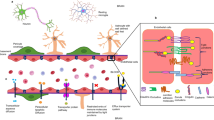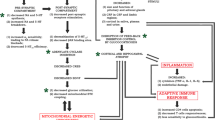Abstract
Depression has become an important disease threatening human health. In recent years, the efficacy of Traditional Chinese Medicine (TCM) in treating the disease has become increasingly prominent, so it is meaningful to find new antidepressant TCM. Mahonia fortune (Lindl.) Fedde is a primary drug in traditional formulas for the treatment of depression, and alkaloids are the main components of it. However, the detailed mechanism of Mahonia alkaloids (MA) on depression remains unclear. This study aimed to investigate the effect of MA on gap junction function in depression via the miR-205/Cx43 axis. The antidepressant effects of MA were observed by a rat model of reserpine-induced depression and a model of corticosterone (CORT)-induced astrocytes. The concentrations of neurotransmitters were measured by ELISA, the expression of Connexin 43 (Cx43) protein was measured by Immunohistochemistry and western-blot, brain derived neurotrophic factor (BDNF), cAMP-response element binding protein (CREB) proteins were measured by western-blot, the pathological changes of prefrontal cortex were observed by hematoxylin–eosin (H&E) staining. Luciferase reporter assay was performed to verify the binding of miR-205 and Cx43. The regulation effect of Cx43 on CREB was verified by interference experiment. Gap junction dysfunction was detected by fluorescent yellow staining. The results confirmed that MA remarkably decreased miR-205 expression and increased Cx43, BDNF, CREB expression in depression rat and CORT-induced astrocytes. In addition, after overexpression of miR-205 in vitro, the decreased expression of Cx43, BDNF and CREB could be reversed by MA. Moreover, after interfering with Cx43, the decreased expression of CREB and BDNF could be reversed by MA. Thus, MA may ameliorate depressive behavior through CREB/BDNF pathway regulated by miR-205/Cx43 axis.
Graphical Abstract









Similar content being viewed by others
Data Availability
Enquiries about data availability should be directed to the authors.
References
Shi Z, Xiao S, Li X (2016) Treatment resistant depression or dementia: a case report. Shanghai Arch Psychiatry 28(2):109–114
Packnett ER et al (2017) Epidemiology of major depressive disorder disability in the US military: FY 2007–2012. J Nerv Ment Dis 205(9):672–678
McHugh RK et al (2013) Patient preference for psychological vs pharmacologic treatment of psychiatric disorders: a meta-analytic review. J Clin Psychiatr 74(6):595–602
Yu T, Su W, Rong L (2015) Research progress of Mahonia (Berberidaceae). J Guizhou Norm Univ (Natural Sciences) 33(3):115–120
KJ, H., L. BM, and L. WJ, Chemical constituents from Mahonia duclouxiana Gagnep.(I). West China Journal of Pharmacy, 2008. 23(2): p. 172-173.
Hong L et al (2019) Advances in chemicai composition, pharmacological action and quality control of mahonia bealei. Guizhou Agric Sci 9(47):122–125
Li YJ et al (2010) Long columns and broad-leaved Mahonia Mahonia Comparative pharmacological effects of aqueous extract. Guiding J Tradit Chinese Med Pharm 16(9):92–96
Li YJ et al (2010) Comparison of pharmacological effects of ethanol extracts from Mahonia longzhuensis and Mahonia broadleaf. Yunnan J Tradit Chinese Med 31(8):61–63
Nadim WD et al (2017) MicroRNAs in neurocognitive dysfunctions: new molecular targets for pharmacological treatments? Curr Neuropharmacol 15(2):260–275
Rajman M, Schratt G (2017) MicroRNAs in neural development: from master regulators to fine-tuners. Development 144(13):2310–2322
Cao T, Zhen XC (2018) Dysregulation of miRNA and its potential therapeutic application in schizophrenia. CNS Neurosci Ther 24(7):586–597
Winter J et al (2009) Many roads to maturity: microRNA biogenesis pathways and their regulation. Nat Cell Biol 11(3):228–234
Bartel DP (2004) MicroRNAs: genomics, biogenesis, mechanism, and function. Cell 116(2):281–297
Wang H et al (2021) Ginsenoside Rg1 ameliorates neuroinflammation via suppression of connexin43 ubiquitination to attenuate depression. Front Pharmacol 12:709019
Xia CY et al (2020) Connexin 43: a novel ginsenoside Rg1-sensitive target in a rat model of depression. Neuropharmacology 170:108041
Wang HQ et al (2021) Novel antidepressant mechanism of ginsenoside Rg1: Regulating biosynthesis and degradation of connexin43. J Ethnopharmacol 278:114212
Zhang NN et al (2022) Connexin 43: insights into candidate pathological mechanisms of depression and its implications in antidepressant therapy. Acta Pharmacol Sin. https://doi.org/10.1038/s41401-022-00861-2
Delvaeye T et al (2018) Therapeutic targeting of connexin channels: new views and challenges. Trends Mol Med 24(12):1036–1053
Chen J et al (2016) Effects of chronic mild stress on behavioral and neurobiological parameters - Role of glucocorticoid. Horm Behav 78:150–159
Xia CY et al (2018) A novel mechanism of depression: role for connexins. Eur Neuropsychopharmacol 28(4):483–498
Zong Y et al (2019) Si-Ni-San prevents reserpine-induced depression by inhibiting inflammation and regulating CYP450 enzymatic activity. Front Pharmacol 10:1518
Tang YQ et al (2019) Venlafaxine plus melatonin ameliorate reserpine-induced depression-like behavior in zebrafish. Neurotoxicol Teratol 76:106835
Chen W-F et al (2017) Neuroprotective properties of icariin in MPTP-induced mouse model of Parkinson’s disease: involvement of PI3K/Akt and MEK/ERK signaling pathways. Phytomedicine 25:93–99
Ye F et al (2019) The regulatory mechanisms of Yulangsan MHBFC reversing cardiac remodeling in rats based on eNOS-NO signaling pathway. Biomed Pharmacother 117:109141
Zhang C et al (2021) Urinary metabonomics study of anti-depressive mechanisms of Millettia speciosa Champ on rats with chronic unpredictable mild stress-induced depression. J Pharm Biomed Anal 205:114338
Zhang H et al (2021) Integrated analysis of the chemical-material basis and molecular mechanisms for the classic herbal formula of Lily Bulb and Rehmannia Decoction in alleviating depression. Chin Med 16(1):107
Wang Y et al (2017) Chinese herbal medicine for the treatment of depression: applications. Effic Mech Curr Pharm Des 23(34):5180–5190
Lu X (2015) Mahonia of the whole plant. For Guangxi 7:21–22
Fiori LM et al (2020) miR-323a regulates ERBB4 and is involved in depression. Mol Psychiatr. https://doi.org/10.1038/s41380-020-00953-7
Yoshino Y, Roy B, Dwivedi Y (2020) Altered miRNA landscape of the anterior cingulate cortex is associated with potential loss of key neuronal functions in depressed brain. Eur Neuropsychopharmacol 40:70–84
Liu J et al (2020) Upregulation of miR-205 induces CHN1 expression, which is associated with the aggressive behaviour of cervical cancer cells and correlated with lymph node metastasis. BMC Cancer 20(1):1029
Xian XS, Wang YT, Jiang XM (2020) Propofol inhibits proliferation and invasion of stomach cancer cells by regulating miR-205/YAP1 Axis. Cancer Manag Res 12:10771–10779
Shen F et al (2018) Genistein improves the major depression through suppressing the expression of miR-221/222 by targeting connexin 43. Psychiatr Investig 15(10):919–925
Morioka N et al (2021) Decreased connexin43 expression in the hippocampus is related to the antidepressant effect of amitriptyline in neuropathic pain mice. Biochem Biophys Res Commun 566:141–147
Zhang Y et al (2022) Xiaoyao powder alleviates the hippocampal neuron damage in chronic unpredictable mild stress-induced depression model rats in hippocampus via connexin 43Cx43/glucocorticoid receptor/brain-derived neurotrophic factor signaling pathway. Bioengineered 13(1):383–394
Xia CY et al (2018) Corticosterone impairs gap junctions in the prefrontal cortical and hippocampal astrocytes via different mechanisms. Neuropharmacology 131:20–30
Ren Q et al (2018) Gap junction channels as potential targets for the treatment of major depressive disorder. Psychopharmacology 235(1):1–12
Sun JD et al (2012) Gap junction dysfunction in the prefrontal cortex induces depressive-like behaviors in rats. Neuropsychopharmacology 37(5):1305–1320
Bjorkholm C, Monteggia LM (2016) BDNF - a key transducer of antidepressant effects. Neuropharmacology 102:72–79
Rosa E, Fahnestock M (2015) CREB expression mediates amyloid beta-induced basal BDNF downregulation. Neurobiol Aging 36(8):2406–2413
Lee YS, Silva AJ (2009) The molecular and cellular biology of enhanced cognition. Nat Rev Neurosci 10(2):126–140
Kaldun JC, Sprecher SG (2019) Initiated by CREB: resolving gene regulatory programs in learning and memory: switch in cofactors and transcription regulators between memory consolidation and maintenance network. BioEssays 41(8):e1900045
Todorovski Z et al (2015) LIMK1 regulates long-term memory and synaptic plasticity via the transcriptional factor CREB. Mol Cell Biol 35(8):1316–1328
Funding
This research was funded in part by National Natural Science Foundation of China (Grant No. 82260776, 81960729), Guangxi Traditional Chinese Medicine Key Discipline Construction Project (GZXK-Z-20–75), Guangxi Natural Science Foundation Project (2022GXNSFBA035505), the State Key Laboratory of Bioactive Substance and Function of Natural Medicines (Open Fund Project No.GTZK202209) and the Key Laboratory Project of Quality Standards of TCM in Guangxi (201902).
Author information
Authors and Affiliations
Contributions
GN, NH, JH and DM designed all the experiments. JH, DM and J were responsible for the experiments, the analyses of data, and the first draft of the article. SF, Z, F, DM Wei, JX and Y assisted with the execution of the experiments. NH, GN, DM and KD assisted with the improvement of the article.
Corresponding authors
Ethics declarations
Conflict of interest
The authors declare no conflict of interest associated with this study.
Additional information
Publisher's Note
Springer Nature remains neutral with regard to jurisdictional claims in published maps and institutional affiliations.
Supplementary Information
Below is the link to the electronic supplementary material.
Rights and permissions
Springer Nature or its licensor holds exclusive rights to this article under a publishing agreement with the author(s) or other rightsholder(s); author self-archiving of the accepted manuscript version of this article is solely governed by the terms of such publishing agreement and applicable law.
About this article
Cite this article
He, J., Li, D., Wei, J. et al. Mahonia Alkaloids (MA) Ameliorate Depression Induced Gap Junction Dysfunction by miR-205/Cx43 Axis. Neurochem Res 47, 3761–3776 (2022). https://doi.org/10.1007/s11064-022-03761-3
Received:
Revised:
Accepted:
Published:
Issue Date:
DOI: https://doi.org/10.1007/s11064-022-03761-3




